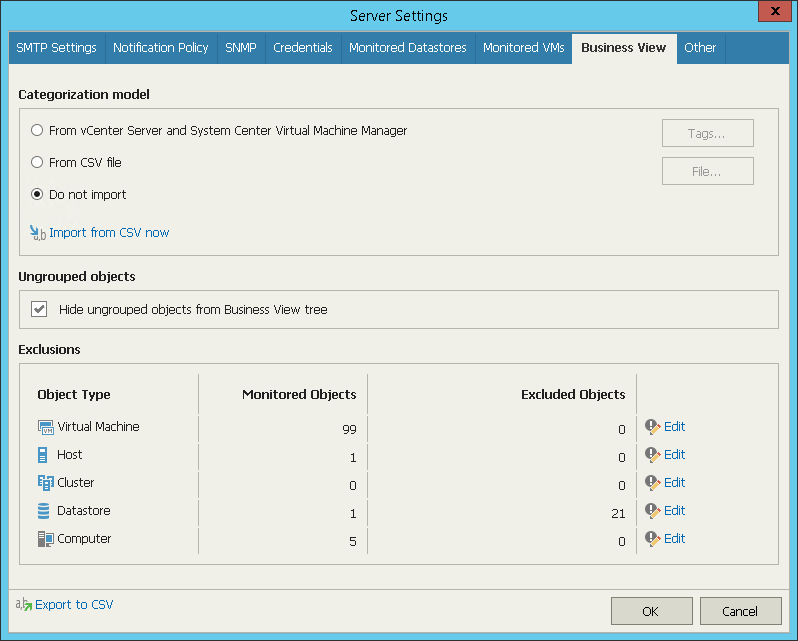 This is an archive version of the document. To get the most up-to-date information, see the current version.
This is an archive version of the document. To get the most up-to-date information, see the current version.Business View
On the Business View tab, you can define the following settings:
- Categorization model — choose whether you want to import an existing categorization model or create your own categories and groups.
- Ungrouped objects — hide ungrouped objects from the Business View inventory tree.
- Exclusions — define objects that must be excluded from categorization.
For more information on Business View categorization, see Business View.
Selecting Categorization Model
To select а categorization model:
- Open Veeam ONE Monitor.
For details, see Accessing Veeam ONE Monitor.
- On the toolbar, click Options > Server Settings.
Alternatively, press [CTRL + S] on the keyboard.
- In the Server Settings window, open the Business View tab.
- In the Categorization model section, select one of the following options:
- From vCenter Server and System Center Virtual Machine Manager — select this option if you have vCenter Server tags or System Center Virtual Machine Manager properties assigned to virtual infrastructure objects, and you want to use these tags and properties to categorize objects in Veeam ONE Monitor.
- From CSV file — select this option if you want to synchronize categorization data between Business View and a 3rd party application using a CSV file.
For more information on configuring data synchronization, see Importing Categorization Data Automatically.
- Do not import — select this option if you want to create a custom categorization model in Business View.
For more information on creating Business View categories, see Creating Business View Categories and Groups.
- Import from CSV now — now select this option if you want to map categorization data from a 3rd party application to Business View groups using a CSV file.
For more information on manual import from, see Importing Categorization Data Manually.
Note: |
You cannot enable synchronization with vCenter Server and System Center Virtual Machine Manager tags and properties and a CSV file at the same time. When you switch between these options or disable import, Veeam ONE Monitor deletes all previously imported categories. |
To hide ungrouped objects from the Business View inventory tree:
- Open Veeam ONE Monitor.
For details, see Accessing Veeam ONE Monitor.
- On the toolbar, click Options > Server Settings.
Alternatively, press [CTRL + S] on the keyboard.
- In the Server Settings window, open the Business View tab.
- In the Ungrouped objects section, select Hide ungrouped objects from the Business View tree.
If you select Hide ungrouped objects from the Business View tree check box, Veeam ONE Monitor will hide the Uncategorized group and all objects within this group from the Business View inventory tree.
For more information on displaying the Business View inventory tree, see Business View.
To exclude objects from Business View categorization:
- Open Veeam ONE Monitor.
For details, see Accessing Veeam ONE Monitor.
- On the toolbar, click Options > Server Settings.
Alternatively, press [CTRL + S] on the keyboard.
- In the Server Settings window, open the Business View tab.
- In the Exclusions section, click the Edit link next to the type of object that you want to exclude.
- [For virtual infrastructure objects] Choose platform for which you want to define exclusions (VMware, Hyper-V).
- In the Edit exclude rules window, specify exclusion conditions:
- From the Property drop-down list, select an object property.
The list contains all object properties that Veeam ONE collects from virtual and backup infrastructure servers.
- From the Operator drop-down list, select a conditional operator.
The list contains the following operators: Equals, Does not equal, Starts with, Contains, Does not contain.
- In the Value field, specify a value that will be checked in the condition.
The condition will be evaluated against discovered objects. To add another condition, click Add Condition.
By default, conditions are linked by the AND operator. That is, an object is excluded when all specified conditions are met. You can change this behavior by linking conditions with the OR operator. In this case, Veeam ONE will exclude an object from categorization when a condition for any of the linked rules is met.
For example, you can exclude VMs based on their power state, datacenter name, and guest OS. If you want to exclude all powered on VMs that reside in datacenter Atlanta or run Linux as their guest OS, you must link these conditions. The second and the third conditions will be linked to each other with the OR operator. The first condition will be linked to them with the AND operator.
To link conditions:
- Select check boxes next to the necessary conditions and click Link.
- In the Rule condition window, select a link operator and click OK.
Linking supports 3 levels of nesting.
- Click Save.
